---
(From "Images of America: Durham" by Steve Massengill)
The Durham Morning Herald grew out of the remains of the Durham Globe and the Durham Recorder in 1894. The first building was constructed on Market Street on a lot purchased from John Sprunt Hill. This shot is taken looking west from Market St.
Below, R.H. Cowan, J.H. King, and E.T. Rollins, Sr. pose in front of the offices of the Morning Herald. The Rollins family would later become sole owners of the paper.
(Courtesy Wyatt Dixon Collection, Duke Archives)
In 1920, the Morning Herald was ready to expand and purchased the insurance building next door.
(Courtesy Duke Archives)
In 1929, the Herald acquired the Durham Sun, which had formerly been located in East Main St. (that building still stands at 306 E. Main). In 1930, the company tore down the above bulidings to build a new Herald-Sun building.
(Courtesy Herald-Sun)
By the 1940s, the Herald-Sun again needed to expand and purchased the buildings to the east of the alley.
(Courtesy Herald-Sun)
The corner of East Chapel Hill and Market St., 1950s. Looking southwest.
(Courtesy Herald-Sun)
Tight shot of a part of the addition, 1950s.
(Courtesy Herald-Sun)
By the 1950s, the paper was ready to expand again - first, with a new addition to the west on East Chapel Hill St.
Above, a rendering of the addition.
(Courtesy Durham County Library)
And - needing still more room, the Herald decided to add a fourth floor to their larger building on Market St. in 1963. Below, a before/in-process picture.
(Courtesy Durham County Library)
09.17.63
And with a completed fourth floor addition, below.
(Courtesy Durham County Library)
In 1977, the Belk Leggett buildings to the west of the Herald-Sun were demolished. Some of this area became parking for the Herald-Sun - I don't know who actually demolished the buildings.
By 1986, the paper was ready to expand once again, and built a large addition on some of the space where Belk-Leggett had been - it allowed loading of trucks in the middle of the 'triangle' of East Chapel Hill, West Main, and Market. However, the paper only used the addition for another 4 years, as they moved out to the Bypass on Labor Day, 1990. The former newspaper buildlings became the 'Bull City Business Center'.
The North Carolina Lambda Youth Network worked out of one of the offices in the 115 Market St building. The North Carolina Lambed Youth Network was formed in July of 1996, as a youth-led leadership organization for LGBT+ youth. The program hosted a variety of events workshops, including ones for LGBT+ youth of color, a multigenerational working group advocating safer schooling for LGBT+ youth, and more.
What does Lambda mean?
The Encyclopedia of Homosexuality edited by Wayne R. Dynes (Garland Press: New York, 1990) defines Lambda as:
"In the early 1970s, in the wake of the Stonewall Rebellion, New York City's Gay Activists Alliance selected the Greek letter lambda, which member Tom Doerr suggested from its scientific use to designate kinetic potential, as its emblem. (Curiously, in some ancient Greek graffiti the capital lambda appears with the meaning fellate, representing the first letter of either lambazein or laikazein.) Because of its militant associations, the lambda symbol has spread throughout the world. It sometimes appears in the form of an amulet hung round the neck as a subtle sign of recognition which can pass among unknowing heterosexuals as a mere ornament. Such emblems may reflect a tendency among homosexuals toward tribalization as a distinct segment of society, one conceived as a quasi-ethnic group."
More Man Than You'll Ever Be by Joseph P. Goodwin (Indiana University Press:Bloomington, 1989), on page 26 defines Lamba as:
The lowercase Greek letter lambda carries several meanings. First of all, it represents scales, and thus balance. The Greeks considered balance to be the constant adjustment necessary to keep opposing forces from overcoming each other. The hook at the bottom of the right leg of the lambda represents the action required to reach and maintain a balance. To the Spartans, the lambda meant unity. They felt that society should never infringe on anyone's individuality and freedom. The Romans adopted the letter to represent "the light of knowledge shed into the darkness of ignorance." Finally, in physics the symbol designates and energy change. Thus the lambda, with all its meanings, is an especially apt symbol for the gay liberation movement, which energetically seeks a balance in society and which strives through enlightenment to secure equal rights for homosexual people.
View of the Market St. buildings, looking west, 2007.
Looking southeast from East Chapel Hill St., 2007
View of the whole former Herald-Sun complex from the corner of East Chapel Hill and Market, looking southwest, 2007.
(Photo copyright Gary Kueber)
05.12.13
(Photo and lensfinger copyright Gary Kueber)
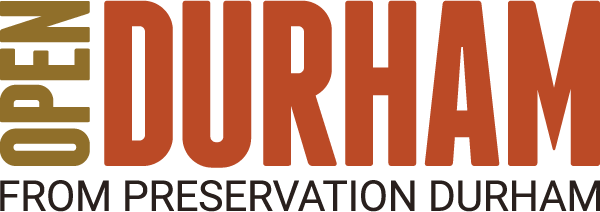
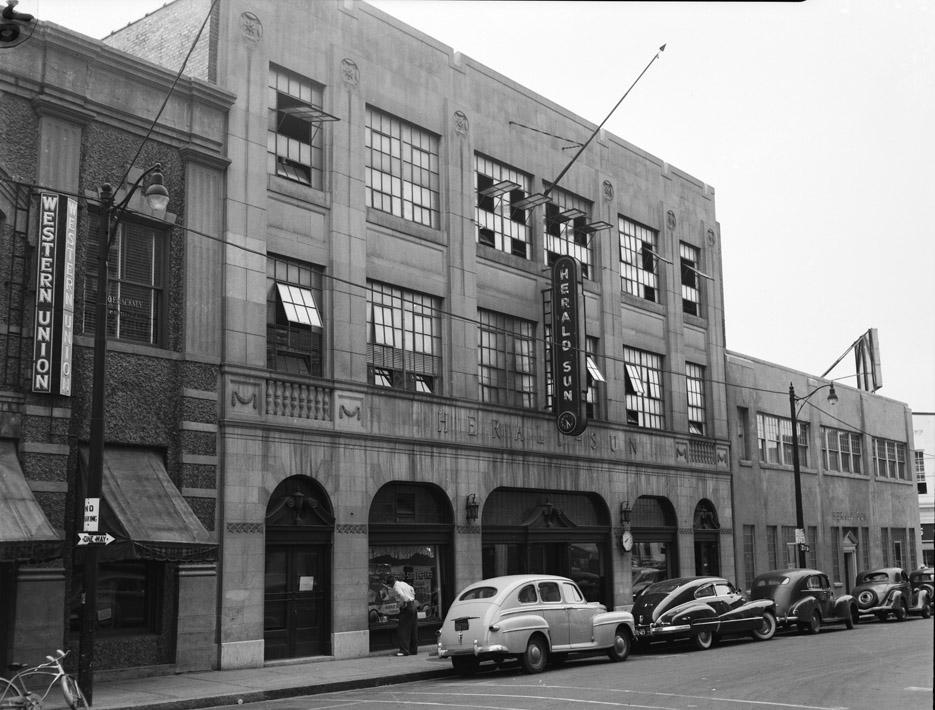
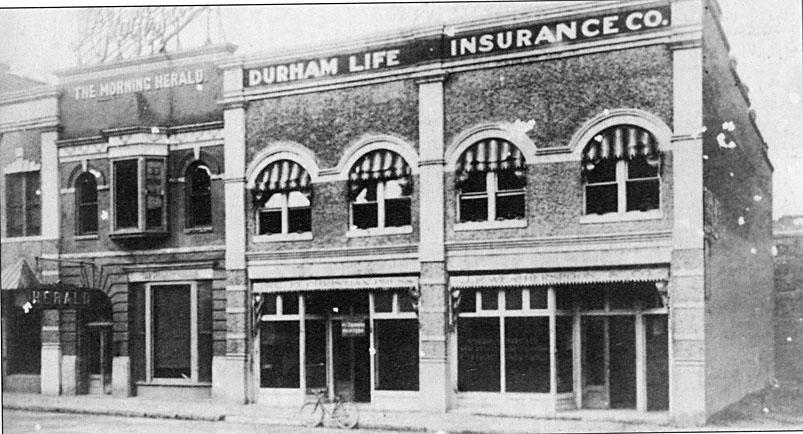
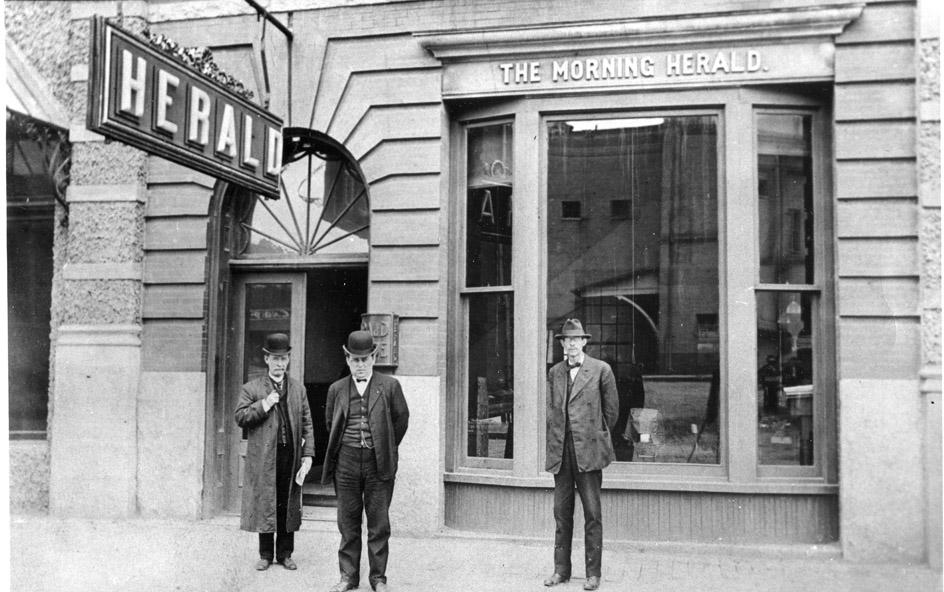
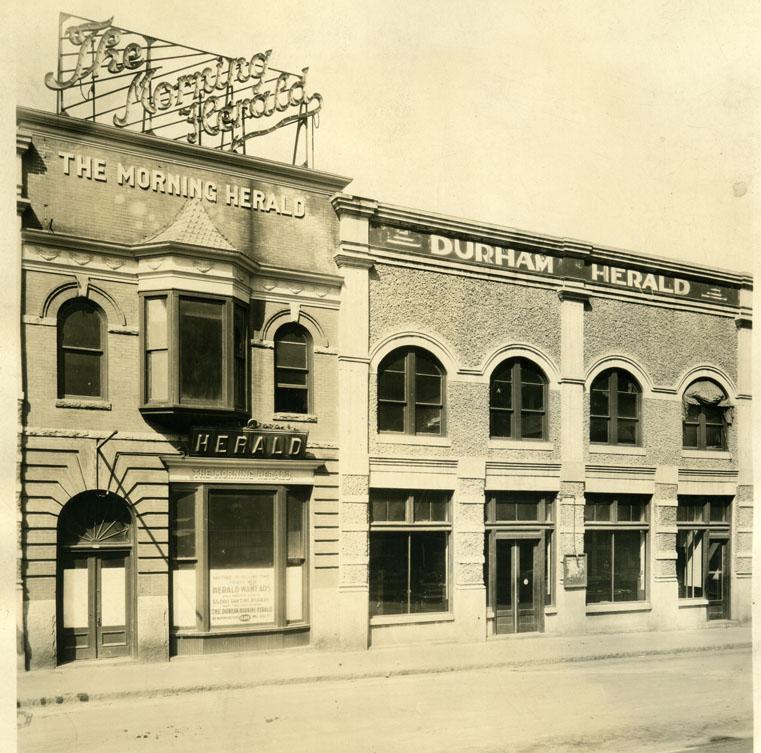
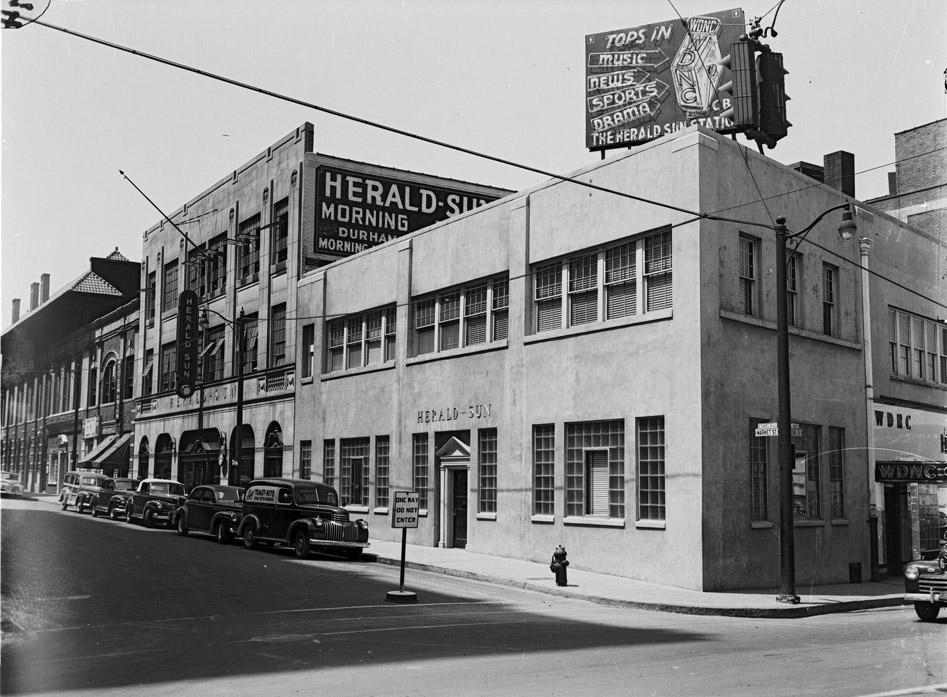
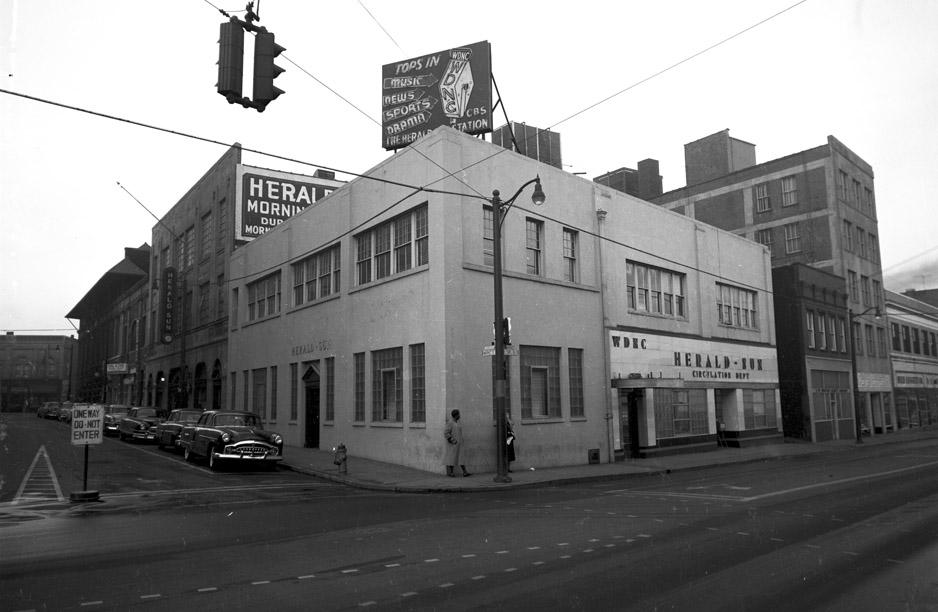
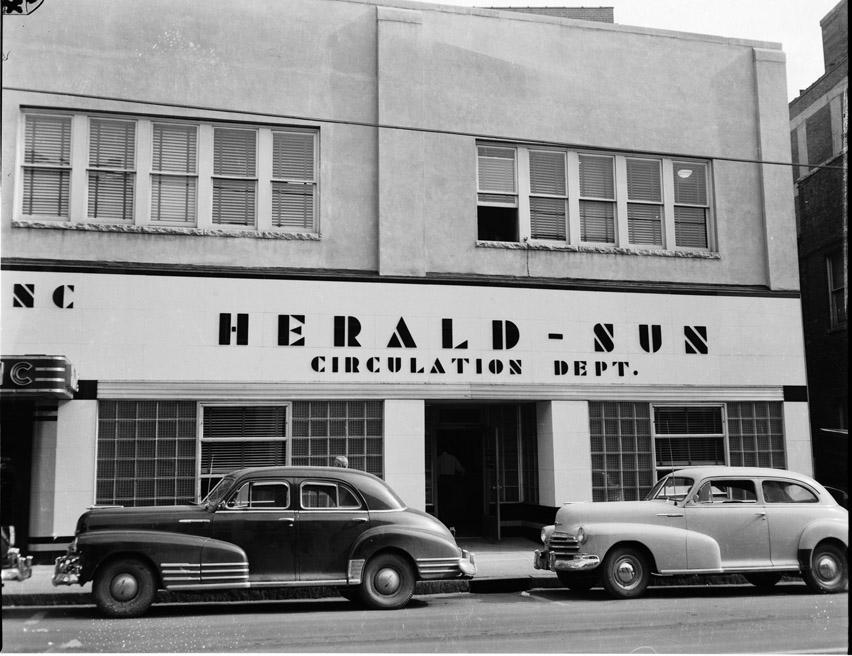
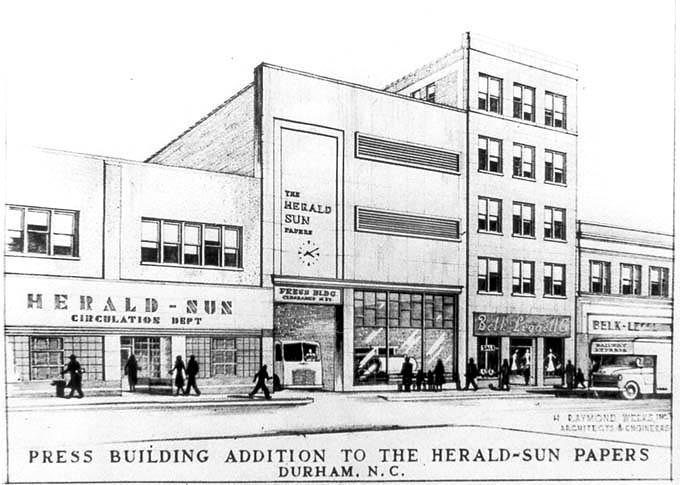
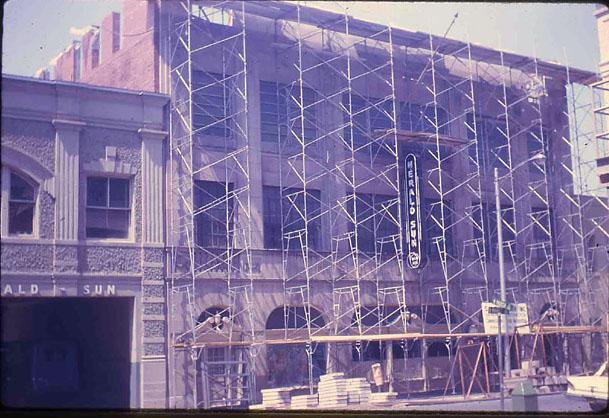
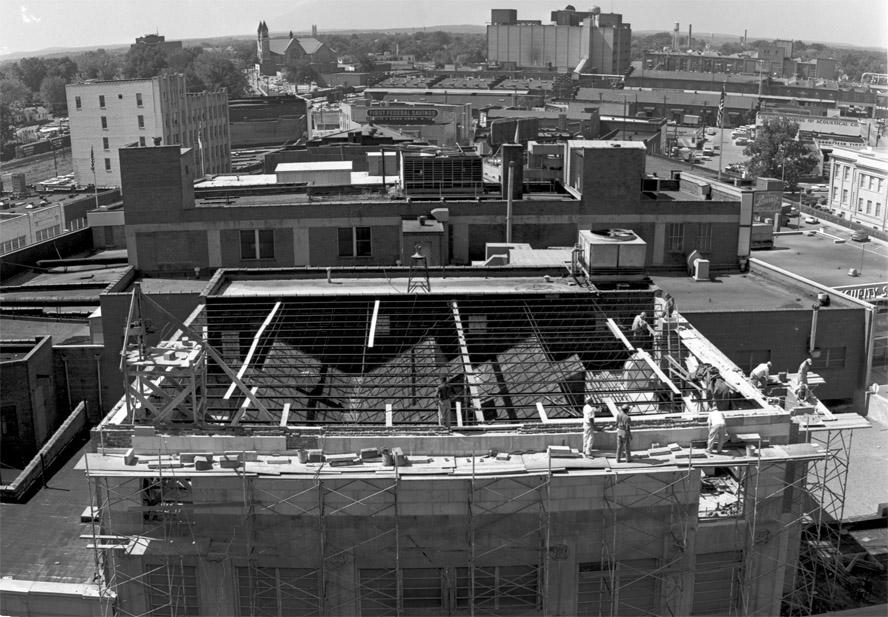
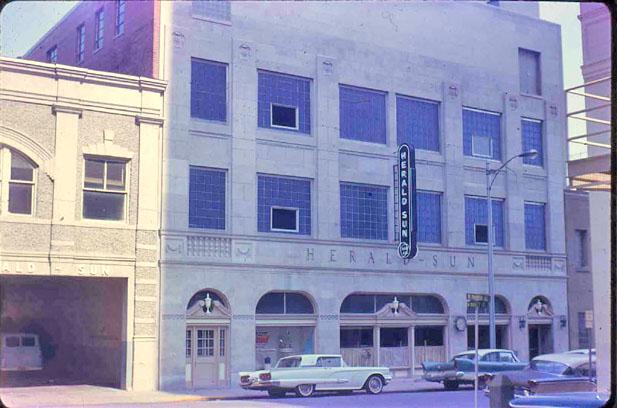
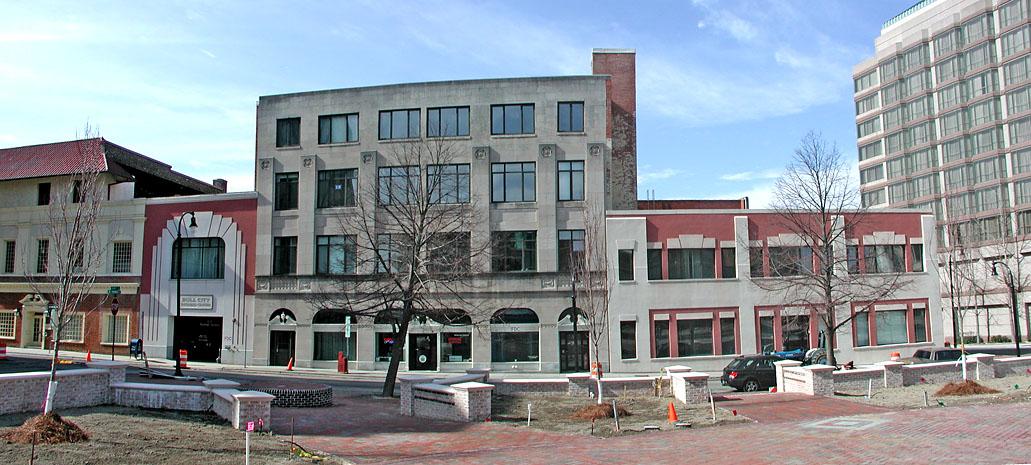
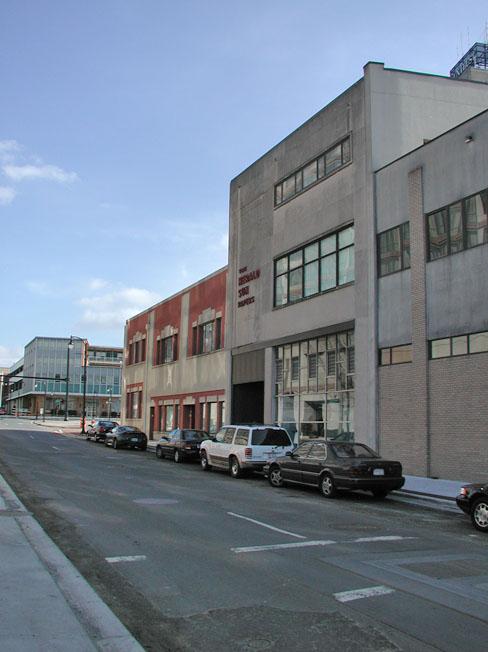
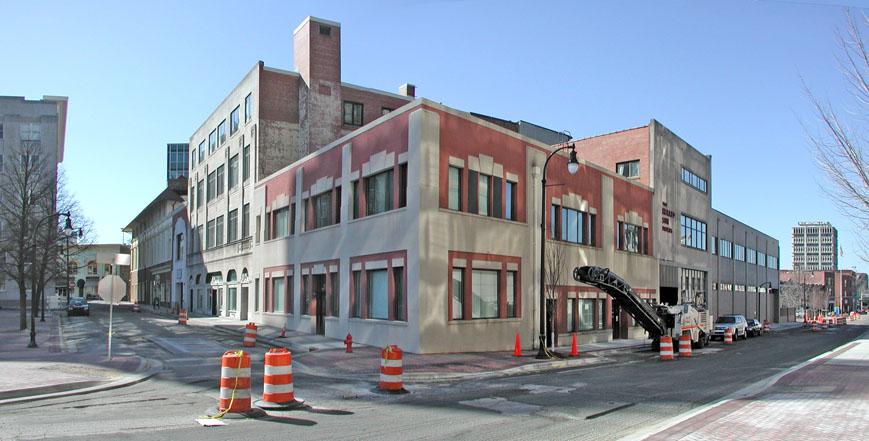
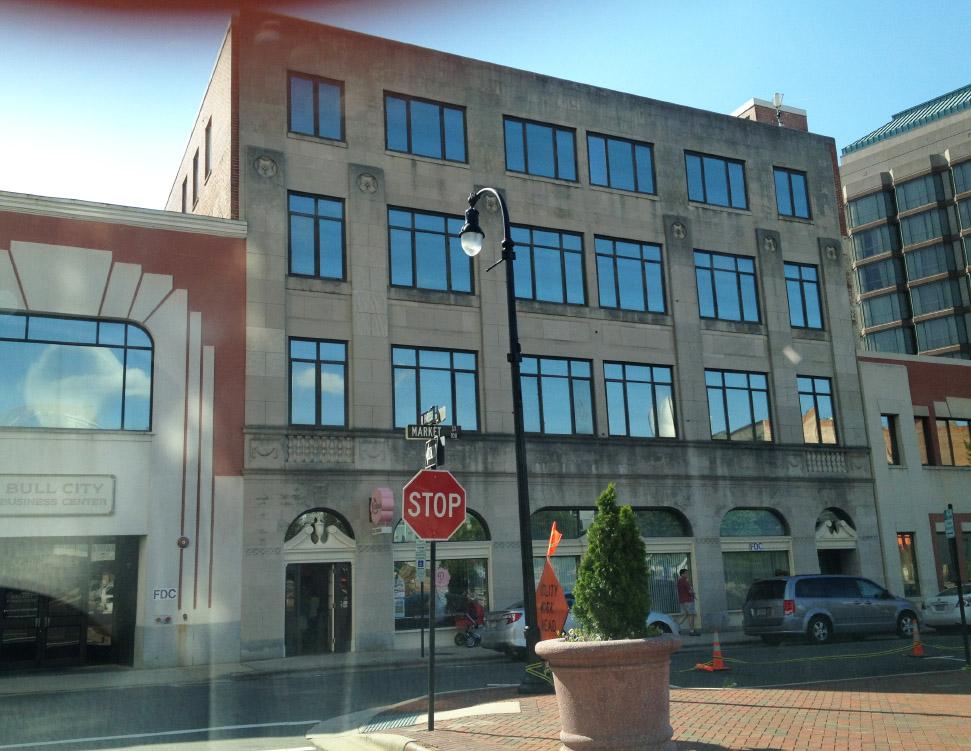
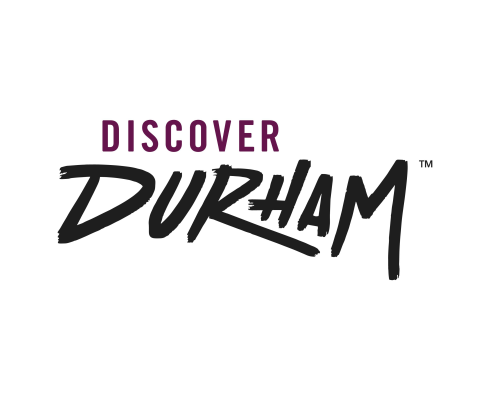
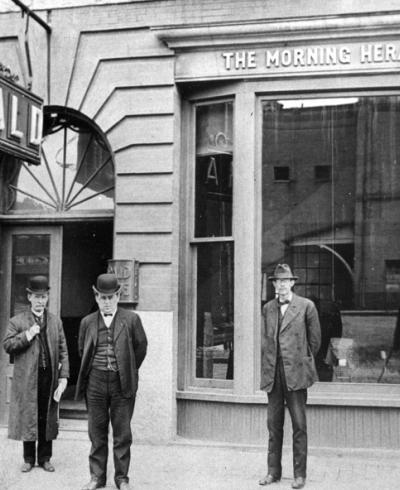
Comments
Submitted by M. (not verified) on Mon, 2/12/2007 - 5:35am
I was wondering if you knew anything about the history of the old dinosaur trail near the museum of Life and Science, and particularly, if you knew where to find photos of what it looked like when it was still in operation. (I have some photos of its current state here: http://eludicate.com/~m/durhamdinopics/index.php?page=0)
I really love the one large dino that's still standing, and am sad to see the ruins of the ones that have been destroyed. (I wish there were a way to save the remaining one- I have heard there are some neighborhood movements afoot to try to do so.) Thanks for any info you might have.
Submitted by Gary (not verified) on Mon, 2/12/2007 - 8:27am
m
Cool pictures; I'm sorry to say that I don't have pictures of the dinosaur trail, but perhaps some readers do - I seem to remember that it was still in decent shape the first time that I saw the museum, which was 1991. The whole museum looked like a 1960s relic at that point.
There was an article by John McCann in the Herald-Sun back in the fall in which he said the museum was planning to build a new dinosaur trail to open in 2008. As I recall, they were rather evasive about saving the old ones, though. The article implied that it had been built in the 1950s or 1960s by someone named Dick Wescott. You might want to email John directly and ask him where to get more info. His email is jmccann (at) heraldsun.com
Hope this is at least somewhat helpful.
GK
Submitted by Daniel (not verified) on Mon, 2/12/2007 - 2:45pm
I wondered why a loading dock was installed there at the corner of Main and Chapel Hill. IMHO that has to be one of the most unsightly buildings downtown. It's the first thing you see when you approach downtown from the west. It seems to say 'Welcome Downtown- now help us unload some of these boxes.'
If I had a magic wand (or lots of money) I'd restore the old flatiron to that corner. Is the loading dock used anymore?
Submitted by Carey (not verified) on Mon, 2/12/2007 - 3:37pm
Do you know when the buildings on either side of the H-S building were given the "hot pink" facade? From the historic photos you posted, it looks like the original building facades underneathe could be nicely restored someday...let's hope.
Submitted by Gary (not verified) on Mon, 2/12/2007 - 3:56pm
Daniel
The loading dock is the location of the Ninth Street Bakery - which used to be located in the current location of Elmo's on Ninth Street. They became a wholesale-only operation downtown for a number of years before reopening a storefront ?5 years ago. Unfortunately most people who don't know downtown well probably wouldn't know it was there, because it is, well, hidden on a loading dock.
If you find that magic wand, let me know.
GK
Submitted by Carey (not verified) on Mon, 2/12/2007 - 5:03pm
All you have to do is knock on the building with your knuckles and you can feel how hollow and cheap the facade is. I say bring back the brick, if anyone is asking for my opinion.
Submitted by Gary (not verified) on Mon, 2/12/2007 - 11:01pm
Carey
I don't know when the hot pink facade was done, although I'd guess late-80s/early 90s. I couldn't agree more about bringing back the original facade if the original brick is still under there on the corner buildings - they do look like the same massing and proportion, so hopefully the original building is still there, but I don't know for certain that they are the same buildings. If they were actually modernist replacements, then you could make a case for returning them to the plain (what I think the historic inventory calls 'austere') facade. Although 'old modernism' isn't popular these days, that would be the historic purist approach.
Submitted by M. (not verified) on Tue, 2/13/2007 - 7:27am
gary- thanks for the info. I'll try John McCann. I do have the phone number for Dusty Westcott, the son of the man who built them (who is now deceased). Perhaps I'll work up the nerve to talk to him sometime. I tried the Museum, since I figured they'd have pictures and historical info, but they never returned any of my calls. Out with the old and in with the new... dinos being no exception, I guess.
Submitted by dcrollins (not verified) on Tue, 2/13/2007 - 10:48am
Somehow I'm related to the Rollins family that started the H-S; as I recall there were two Rollins brothers in the 1800s, one of whom started the paper in Durham and the other who moved to Henderson. The latter line went into medicine, and sometime later a Dr. Rollins became the personal physician to President Hoover I believe. This line continued to my great grandfather E.M. Rollins, Sr., who integrated the schools (and has both a street and elementary school named for him); the medical tradition extended to my uncle Charles Dick Rollins, who ran the health departments for Granville and Vance counties (and has part of the hospital named after him in Henderson). My cousin Marian Rollins Raval has kept up the tradition and is currently a surgical intern in Pittsburgh.
I've been meaning to reach out to the Rollins family since moving to Durham, especially now that ETR, Sr. has passed on, but I'm not sure who is still alive in the area. I think his son lives in NY.
Submitted by Gary (not verified) on Tue, 2/13/2007 - 12:15pm
Dave
That's quite a lineage. It was actually ETR, Jr. that just died recently; his wife is still alive, though, and active in several local organizations. I'd start with her.
GK
Add new comment
Log in or register to post comments.